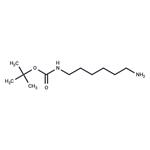Chemical Properties
Off-White Solid
Uses
N-Boc-1,6-diaminohexane is used to prepare 1,3-Bis[6-(Boc-amino)hexyl]urea by reacting with carbonyl dichloride in the presence of triethylamine. Further, it is used as a reagent for the introduction of a C6-spacer.
Application
N-Boc-1,6-hexanediamine can be used as a linear hexyl spacer (C6-spacer) to synthesize:
Biodegradable poly(disulfide amine)s for gene delivery.
A multifunctional dendrimer for theranostics.
Polyamide platinum anti-cancer complexes designed to target cancer specific DNA sequences.
Self-assembled monolayers (SAMs) that resist adsorption of proteins.
[N-(6-(4-Hydroxy-6-isopropylamino-1,3,5-triazin-2-ylamino)hexyl)-5-hydroxy-1,4-naphthoquinone-3-propionamide] (JUG-HATZ), which can be used in designing electrochemical immunosensors.
Preparation
synthesis of N-BOC-1,6-diaminohexane: 1,6-Diaminohexane 3 (Fig. 1) (100 g, 0.86 mol) was dissolved in CH2Cl2 (300 ml) and cooled in an ice bath to 0–3°C. To the stirred solution 0.3 eq. di-tert-butyl bicarbonate (62.6 g, 0.29 mol) was added slowly over a period of 1 h. The reaction was allowed to warm up to r.t., and proceeded overnight. The reaction mixture was extracted with saturated aqueous NaHCO3 (50 ml, three times). The organic phases were pooled, dried, and evaporated under reduced pressure. The resulting oil was dissolved in 200 ml, 1 N HCl and extracted with ether. The aqueous phase was washed with ether, made basic to a pH of 10 with aqueous 2 N NaO3, and extracted with ethyl acetate. The organic phases were pooled, dried, and evaporated under reduced pressure. The resulting oil was dissolved in 200 ml, 1 N HCL and extracted with ether. The aqueous phase was washed with ether, made basic to a pH of 10 with aqueous 2 N NaOH, and extracted with ethyl acetate. The organic extracts were pooled, dried over Na2SO4 and evaporated to give 10.5 g of homogeneous N-BOC-1, 6- diaminohexane 2c (Fig. 1) as a yellow oil which was used without further purification.
TLC Rf 0.51; 1H NMR (CDCL3) d 4.54 (bs, 1H; NH), 3.05 1 2.62 (m, 4H; NCH2), 1.41 (m, 9H; CH3), 1.29 (m, 8H; CH2).
Evaluation of aminoalkylmethacrylate nanoparticles as colloidal drug carrier systems. Part I: synthesis of monomers, dependence of the physical properties on the polymerization methods
reaction suitability
reagent type: cross-linking reagent





